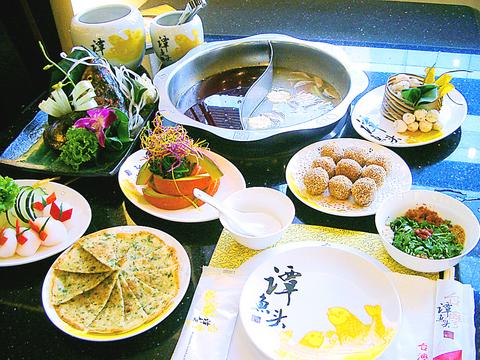To say that Taiwan Tan Yutou is popular would be an understatement. Since it opened in the middle of September, tables have been full and lines have run out of the door every evening at dinner time. Reservations must be made at least one week in advance.
Tan Yutou is one of the more successful chain restaurants in China, with 91 branches on the mainland and sales last year of 450 million yuan. Taiwan Tan Yutou is branch No. 92. Combine the restaurant's reputation with Taiwan's addiction to Sichuan hot pot, and you get a recipe for big business.
Upon entering Tan Yutou's three-storey building, guests are immediately greeted with the aroma of chili peppers and Chinese herbs. This is the smell of the spicy red hot pot's secret sauce. Tan Yutou's central kitchen in Chengdu, Sichuan makes the sauce and then sends it vacuum-sealed to its different branches. "We wouldn't be able to make the soup without it," said Yvonne Wang (

PHOTO: YU SEN-LUN, TAIPEI TIMES
What really makes Tan Yutou stand out is its chili peppers. These come from Sichuan and farmers have a seven-day window to pick them. If harvested too early or too late, they won't taste quite so good. The chili peppers are picked according to this schedule and promptly vacuum-sealed. This way "it only feels hot in your mouth, not in your throat or stomach," Wang said. According to Wang, this is another reason why the restaurant is so popular.
For the less adventurous, the tomato pot is a good choice, eaten with slices of meat and fish balls. Its thick red broth is rich and smooth on account of the vacuum packed tomato sauce that's shipped in from Xinjiang.
And then there is Tan Yutou's house specialty -- fish head hot pot. A fish's head is rich in nutrients and it makes the hot pot's soup more flavorful. It comes in three flavors -- spicy fish head, tomato fish head and white (light) fish head.
The dipping sauce for the meat is also unique in Tan Yutou. You mix fried soy beans, pickles, the house chili bean sauce and chicken stock into a saucer, into which the waiter adds spicy oil. If you want your sauce to be extra spicy, just ask for more oil.
At Tan Yutou, as in Sichuan, they finish off a luxurious meal with a bowl of dan-dan noodles (dry noodles with chili oil and peanut powder), a few green onion pancakes, yam cakes or pumpkin pancakes.
For those who don't know what to choose from the numerous items from the menu, there is a set menu (four persons for NT$3,000), which gives you 13 dishes including two different kinds of hot pot with fish head, beef ribs, lamb, dan-dan noodles and green onion pancakes.

In the March 9 edition of the Taipei Times a piece by Ninon Godefroy ran with the headine “The quiet, gentle rhythm of Taiwan.” It started with the line “Taiwan is a small, humble place. There is no Eiffel Tower, no pyramids — no singular attraction that draws the world’s attention.” I laughed out loud at that. This was out of no disrespect for the author or the piece, which made some interesting analogies and good points about how both Din Tai Fung’s and Taiwan Semiconductor Manufacturing Co’s (TSMC, 台積電) meticulous attention to detail and quality are not quite up to

April 21 to April 27 Hsieh Er’s (謝娥) political fortunes were rising fast after she got out of jail and joined the Chinese Nationalist Party (KMT) in December 1945. Not only did she hold key positions in various committees, she was elected the only woman on the Taipei City Council and headed to Nanjing in 1946 as the sole Taiwanese female representative to the National Constituent Assembly. With the support of first lady Soong May-ling (宋美齡), she started the Taipei Women’s Association and Taiwan Provincial Women’s Association, where she

Chinese Nationalist Party (KMT) Chairman Eric Chu (朱立倫) hatched a bold plan to charge forward and seize the initiative when he held a protest in front of the Taipei City Prosecutors’ Office. Though risky, because illegal, its success would help tackle at least six problems facing both himself and the KMT. What he did not see coming was Taipei Mayor Chiang Wan-an (將萬安) tripping him up out of the gate. In spite of Chu being the most consequential and successful KMT chairman since the early 2010s — arguably saving the party from financial ruin and restoring its electoral viability —

It is one of the more remarkable facts of Taiwan history that it was never occupied or claimed by any of the numerous kingdoms of southern China — Han or otherwise — that lay just across the water from it. None of their brilliant ministers ever discovered that Taiwan was a “core interest” of the state whose annexation was “inevitable.” As Paul Kua notes in an excellent monograph laying out how the Portuguese gave Taiwan the name “Formosa,” the first Europeans to express an interest in occupying Taiwan were the Spanish. Tonio Andrade in his seminal work, How Taiwan Became Chinese,